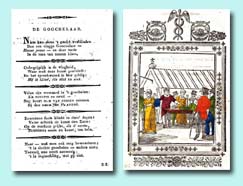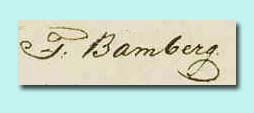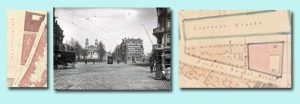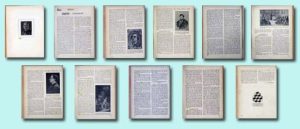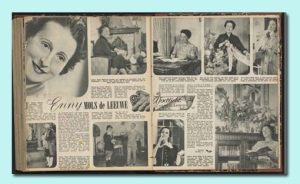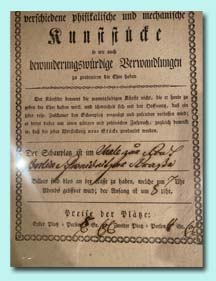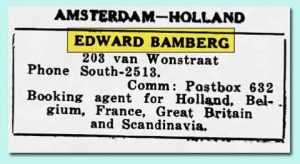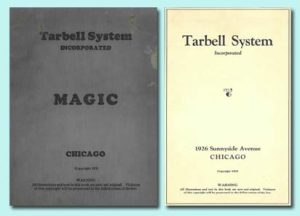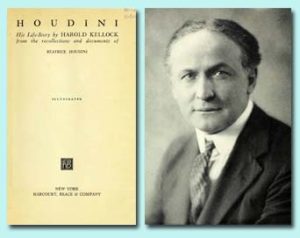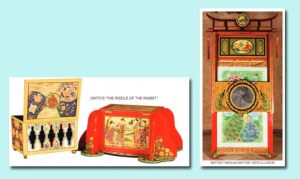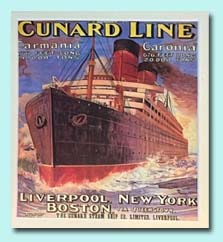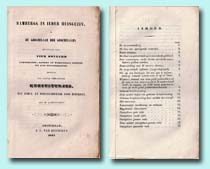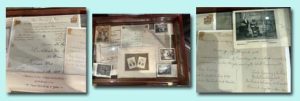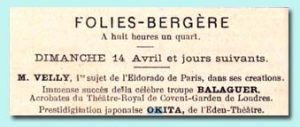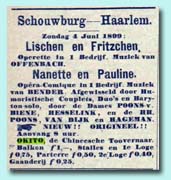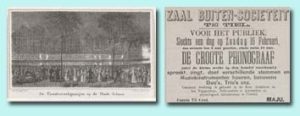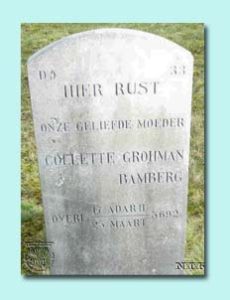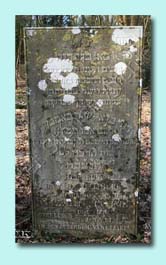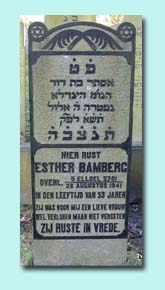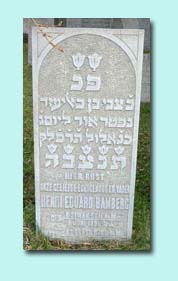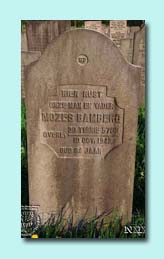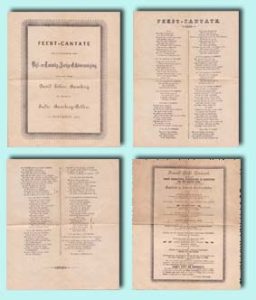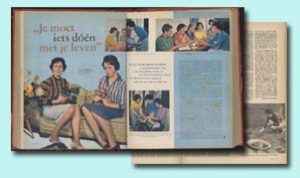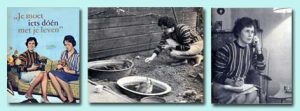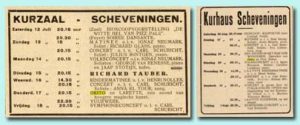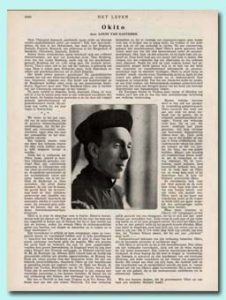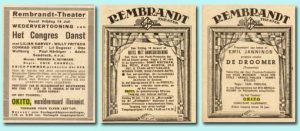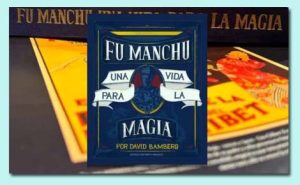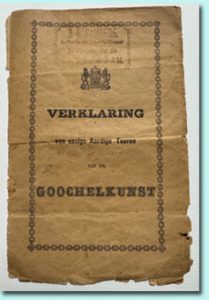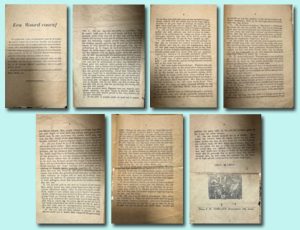No supplements will be made of the book (?) PDF (?) of the Bamberg dynasty of magicians.
New findings will be published on this page. Reference is made to the pertaining chapter in the book (?) PDF (?)
Er worden geen supplementen gemaakt van het boek (?) PDF (?) van de Bamberg-dynastie van goochelaars. Er wordt gerefereerd aan het betreffende hoofdstuk in het boek (?) PDF (?)
Nieuwe bevindingen worden op deze pagina gepubliceerd.
Update October 2024:
-1- A wooden leg. On page 34 of chapter 3, a drawing showed the magician with the wooden leg, Eliazer David Bamberg. It was black and white. A poem belonged to it. A colored version of this illustration appeared, along with the poem. Now, “D.L.” in the corner of that poem was noticeable, suggesting that it was Eliazer’s son David Leendert, who put this together. Chapter 3.
-2- Marriage Kinsbergen-Bamberg. When Judic Bamberg and Levie Kinsbergen married on November 13, 1851, they signed their marriage certificate. We also see the signatures of Judic’s parents; not every woman could write in those years, but mother Mariana Schrijver obviously could. Added are the signatures of the bride’s witnesses, their brothers Eduard and Tobias Bamberg. The signature below the last witness is Marcus Simon Kinsbergen, music master, cousin of the groom. (Also known as Meijer Simon). Chapter 4.
-3- A signature. Signature of Tobias David Bamberg, at the birth certificate of his daughter Betje Bamberg. Chapter 6.
-4- The house at the Muiderplein. The residence of Tobias David Bamberg. He lived there with his family and eventually he and his brother-in-law Nagman Delden established their Kollegiekamer (see chapter 6, page 128). It is the building between the Nieuwe Amstelstraat (at right) and the Waterlooplein. The street maps show how the address Joden Amstelstraat was changed to Muiderplein. The adjacent streets then still had their old names: Joden Amstelstraat and Leprozengracht. The latter would become part of today’s Waterlooplein. Chapter 6.
-5- An interview with Okito in the Netherlands. In March 1939, the Dutch artists’ magazine Morks Magazijn placed an eleven-page article entitled Okito over Goochelen (Okito about magic). The article begins with the observation that, in these dangerous and difficult times, fortunately, childish pleasures are still maintained. Okito, the Chinese conjurer, a Dutchman as Chinese, is presented in this article that primarily deals with well-known facts that were already described in our book. Also here, the alternative story was told that it was the impresario Frits van Haarlem, with his famous variety company, who thought that it was a brilliant idea to introduce a mute magician as a variation on the eloquent magicians, who would radiate something of the mysticism of the Eastern magicians precisely in his silent role. Okito said that his children were born in America (but son David was born in the UK) and that one of his grandsons was born in the Celestial Empire itself. (A new example of Okito’s fantasy stories). During the interview, his faithful helper appeared, who was tidying the dressing room in the fantastic costume of a Chinese beauty (this must have been Marie Dean). Among other far-away countries where he performed, Okito mentioned China and that he visited the Dalai Lama in Tibet with his son David, the South American illusionist Fu-Manchu (father and son never went there). Other stories followed, one more likely than the other: he has performed magic for the American presidents Taft, Roosevelt, and Wilson, for King Edward VII of England, King Christian of Denmark, King Alfonso of Spain, and for the former Sultan of Turkey. From the King of Siam, he received a magnificent diamond ring, which he still wears with understandable pride. Okito mentioned that, in his early youth, he lived next door to the later famous Dutch entertainer Buziau, with whom he remained friends since childhood. “Even now, in Rijswijk, we live close to each other again and often reminisce about our shared childhood memories.” While speaking about the studio in his house, he speaks about the true treasures that he brought home from the Celestial Empire (where he never was). This is only a brief excerpt from the interview with and reporting about Okito. Chapter 17.
-6- Enny Mols-de Leeuwe in the limelight. In December 1951, a richly illustrated article appeared on Enny Mols-de Leeuwe. (See chapter 15). She was the daughter of Rebecca Bamberg, the oldest child of David Tobias “Papa” Bamberg. Chapter 15.
-7- An early foreign Bamberg performance. Bruce Averbook from Cleveland, who helped with illustrations about Okito and Fu-Manchu (see e.g. chapter 17 page 992), sent in a poster from Abraham Leendert Bamberg (chapter 5, with the text “With the approval of the authorities, on Sunday and Monday, July 13th and 14th, 1823, the student of the famous artist Pinetti A.L. Bamberg will have the honor of producing various physical and mechanical tricks as well as admirable transformations for the second time. The artist does not name the various tricks that he will have the honor of performing today and flatters himself with the hope that every … spectator will leave the venue happy and satisfied; he therefore asks for a kind and numerous responses, at the same time noting that new pieces will be produced at each performance. The venue is in the hall … Berlin … Tickets are only available at the box office, which opens at 7 p.m.; the show begins at 8 p.m. Prices of seats: First rank 8 groschen per person. Second rank: 4 groschen per person. Chapter 5.
-8- A Bamberg as tutor. In the early twentieth century, David Samuel Bamberg advertised as a tutor in the students’ magazine of the Technical University of Delft. He then lived in nearby The Hague. Chapter 14.
-9- Bamberg, the international impresario. In June 1922, Eduard Henri Bamberg advertised in The Vaudeville News as a booking agent for Holland, Belgium, France, Great Britain, and Scandinavia. He lived in Amsterdam. Chapter 23.
-10- The Tarbell System – a good start for Fu-Manchu. The book Tarbell System was published in 1926. In chapters 17 and 24, this book was mentioned. Okito then lived in Europe but after his return to the USA he and Harlan Tarbell would become friends. Okito is mentioned is that book. Tarbell sent his book to Okito’s son David which was a source of inspiration for David when setting up his Fu-Manchu show in Argentina. Chapter 24.
-11- Harry Houdini, Okito’s friend. In 1928, the book Houdini was published on the basis of recollections and documents of his wife Beatrice.Both Harry and Beatrice Houdini were mentioned in chapter 17. Chapter 17.
-12- More props made by Okito. In 2021, pictures of props made by Okito were published in The Linking Ring. Chapter 17.
-13- Recent Bambergs presented. In October 2000, Henri Eduard Gijsbert Bamberg passed away, at the age of 53. He did not appear before in the genealogy. He was born on May 4, 1947 as a son of Henri Eduard Bamberg. We see that Henri Eduard was married with Gerardina Maria Anna Antonetta Craane, born January 27, 1946 in Den Bosch. They became parents of a twin whose names are not disclosed here for privacy reasons. Chapter 23.
-14- A Bamberg’s departure to the UK. On December 28, 1915, Eduard Henri Bamberg was deregistered from his address in Amsterdam (Van Woustraat) to London. Chapter 23.
-15- A ship that brought the Bambergs to the USA. Many years, I sat in my local pub right next to a set of posters. Only recently, it hit me that one of these showed the Caronia, the ship of the Cunard Line that brought Okito with his family and his brother to the USA in 1907. Chapter 17.
-16- More data about Fu-Manchu. In 1979, Claudinet (Justo Torrecillas Ruiz), the actor who worked with David Tobias Bamberg (Fu-Manchu) for a long time (see chapter 24), published the Origen e Historia de la Magia. Okito is mentioned a few times, about disappeared items (two items of a unique booklet, stored before in Salta, Argentina and various catalogs of the houses “CASA OKITO” and others. Lola Cámara, the widow of David Tobias Bamberg, is thanked for her contribution to Claudinet’s work. Fu-Manchu and Lola are mentioned multiple times. Some facts and names were already part of chapter 24 but much background was added in this document. For example, an artist named José Luís Rodríguez “Macaco”: on one of his tours, he met the famous magician “Fú Manchú” in Havana who recruited him for his show, touring all of Latin America and finally settling in Buenos Aires. When Fú left, he made him enter the Teatro Avenida, where fate would have it that he would find death. Someone saw David in Teatro Súper Cine. When Santer, a great artistic festival was organized for a circus artist, one of the performances was given by Fu-Manchu, the king of magicians. Fu-Manchu consulted the magician Carlos H. Colombi on some occasions to improve his show as much as possible. Dr. Hugo M. Puiggari “Mephisto” had a large collection of authentic Chinese costumes and kimonos belonging to Fu-Manchu (140) in total. Its material is valuable and varied, which allows it to organize shows of all kinds. Eduardo Subirana “Piuman” bought some of Fu-Manchu’s sets, including the front curtain, a real “tapestry” and the presentation book of the Bamberg dynasty (now we know where such items went to); he has a set of devices of great magical and intrinsic value. Most of these devices have been manufactured in Salta by skilled craftsmen under the direction and plans given to him by Fu-Manchu. In 1962, at the Segundo Congreso Mágico Argentino Internacional, a 68-page magazine was published, which contained, in addition to curious facts about magic, dates and the constitution of Magical Entities in the country, a large number of biographies of magicians such as Fu-Manchu. In one of Fu-Manchu’s last performances in Salta, Piuman went to greet him and introduced himself, and in this way a frank friendly current was established between: Fu-Manchu, Alex Mir, and Piuman that was maintained through a fluid correspondence between the three. At the 35th anniversary festival of Fundación del C.M.A., in September 1973, on the occasion of the 35th anniversary of its foundation. For this reason, the C.M.A. awarded medals of the Circle to the founding members. The Grand Prize of the C.M.A. was awarded to Mr. David t. Bamberg “Fú Manchú”. Afterwards, a magic festival was held at the Margarita Xirgu Theatre, in which well-known magicians, among whom Colombi, Mephisto, Claudinet and the world-renowned magician Fu-Manchu collaborated with their performances. We know that Fu-Manchu was guest of honor at many occasions and here we see that he was a special guest at congresses in 1971 and 1972 in Mar del Plata. In 1970, a Federation of Magical Entities was found and an Organizing Committee was formed with Fu-Manchu as the honorary president. We know that Fu-Manchu appeared on television. Nicolas “Pipo” Mancera brought magicians of the category of Fu-Manchu to his program, although he was reluctant to appear on television, but Mancera took advantage of his great friendship with him to take him to his “Circular Saturdays”, and once there, he “improvised” a friendly magical competition between the “master and the student”, which was equivalent to several tests with cards carried out by the master and one by the student. On Channel 13, in the program Volver A Vivir from the well-known television program producer Blackie, one was dedicated to Fu-Manchu, and several magicians and friends collaborated on it, among whom Mephisto, Colombi, Yukito, Vernet and Claudinet, all names we see in chapter 24. On the same channel several magic “spectaculars” were made. One was presented and commented by Fu-Manchu. Fu-Manchu always liked to go to the meetings of the C.M.A., on Mondays at Avda. de Mayo 796 and on Fridays at Chacabuco 863. On Av. de Mayo. Before the meeting, he would go to dinner in frank camaraderie at the Restaurant Victoria and at the Casal. After dinner they went to their little theater and did magic. At one of those occasions, The meeting was dedicated to him and we all did something, even Fu-Manchu performed. When it was Claudinet’s turn, he did a test with coins. He was presenting his trick when Fu said to him “Hey, can I ask you a question?” “Yes, of course you can.” “Did you do America?” The question left him a bit perplexed and he said to him: “Why do you ask that?” “I say this because when we just arrived in Argentina you did this same test with copper coins, and now they are gold.” The appearance of Fu-Manchu of course caused some laughter, since Fu, apart from being a great magician, was a witty conversationalist. In October 1979, the Municipal Museum of the city of Buenos Aires opened a Magic Exhibition with the motto: “Magic in Buenos Aires” which was a real success as a large number of visitors passed through its halls. In this exhibition there was a bit of everything, large devices, among them the trunk that the famous magician Fu-Manchu used in his long magic life doing with it “the triple escape”. Chapter 24.
-17- A personal token for a descendant. Liz Bamberg, granddaughter of Fu-Manchu, sent a picture of a silver pin with the form of her famous ancestor. It is based on the well-known caricatures of Fu. Chapter 24.
 -18- Bamberg-made literature. In 1847, the booklet on magic Bambergg (sic) in ieder huisgezin was published. It is not certain if this was on behalf of one of the Bamberg members but if so, that might have been either David Leendert Bamberg or Tobias David Bamberg. Chapter 4 or 6.
-18- Bamberg-made literature. In 1847, the booklet on magic Bambergg (sic) in ieder huisgezin was published. It is not certain if this was on behalf of one of the Bamberg members but if so, that might have been either David Leendert Bamberg or Tobias David Bamberg. Chapter 4 or 6.
-19- One of the many Bamberg collections. Bruce Averbook, Cleveland, contributed to the book with several pictures that could be published in it. In his drawers, there are more documents about Okito, Fu-Manchu and relatives. Partly visible are: (1) a letter in Dutch, by David Tobias “Papa” Bamberg, with his printed letter head; (2) a note by or about him in English and (3) a printed note in German (Seinem lieber Talma Bellachini” gewidmet von Papa Bamberg & Sohn – “To his dear Talma Bellachini” dedicated by Papa Bamberg & Son). Chapter 11, 17 and 24.
-20- Playing with Okito’s Floating Ball. In one of her books, the popular Dutch author Yvonne Keuls-Bamberg, told a story about children who play and perform with the Golden Ball of Okyto (sic). Chapter 17.
-21- Okita in Folies-Bergère. An advertisement in April 1889 of the performance of the magician Okita in the famous Folies-Bergère in Paris, reminds us of the dispute with her about the origin of the name Okito, as described in chapter 17. Chapter 17.
-22- Okito in Haarlem. An advertisement of June 1899 for a performance of Okito, the Chinese (sic) magician, in the theater of the city of Haarlem. Remarkable because Okito was performing as a Japanese, long before he converted his act to Chinese. We see names Poons, which also appear in the book. Chapter 17.
-23- Levie Kinsbergen – A versatile artist. A thorough study by Dulce da Rocha Gonçalves, Utrecht University, The Netherlands, discusses Levie Kinsbergen (1823-1886), known as Maju. Kinsbergen was married with Judic Bamberg (see chapter 4). It would go too far to repeat the entire article in this context. Maju was mentioned as a science popularizer. The author argues that Maju, who came from the world of entertainment rather than science, played a significant role in the introduction of science and technology to the Netherlands. Levie’s father Meijer Kinsbergen used the stage name Maju before it was adopted by his son. The Kinsbergen family was a Dutch Jewish family with many connections to the entertainment industry, namely itinerant shows in Dutch fairgrounds. During the 1850s, L.K. Maju styled himself as Professor of Sleight-of-Hand and toured the country’s theater venues, coffee houses, and fairgrounds with Soirées Amusantes, which included conjuring acts and experimental physics. Between 1863 and 1864, Maju worked in London. Maju’s association with Polytechnic turned out to be a fruitful and long-lasting endeavor that widened the scope of his performances. Maju exported Polytechnic’s sensational Pepper’s Ghost, which would become known in the Netherlands as De Geest van Maju (The Ghost of Maju) and the cabinet-based illusion The Sphinx. This choice enabled Maju to include the Ghost in a profitable circuit, reaching audiences across the Netherlands, while making use of his family network. Maju skipped the fairground circuit and performed the illusion in permanent indoor theaters throughout the country, following the first very successful performances at the Paleis voor Volksvlijt (the Dutch Crystal Palace). Maju added other acts (such as microscopic and agioscopic, or opaque, projection), offering evening programs which included three to four sections, lasted about 2 hours and which he advertised as scientific performances. Maju devised a new repertoire based on magic lantern lectures and technological innovations, which he signed as Maju, no longer Professor of Sleight of Hand, but Member of Polytechnic. Nineteenth century scientific performance was an active and expansive field. Maju needed more than his stage and conjuring skills, for instance, to be able to flawlessly operate complex instruments such as the oxy-hydrogen microscope. Maju performed the magnification of water droplets, living cheese mites and bacteria samples to appreciative Dutch audiences well into the 1880s. Besides successfully manipulating the oxyhydrogen microscope on stage, Maju also prepared his own microscopic slides. In 1873, in cooperation with the Amsterdam Royal Zoological Society Artis, he submitted an entry to the International Exhibition of Sea and Fisheries in Berlin: a set of nine prepared microscopic slides displaying the development of salmon. Maju was awarded the silver medal at the Berlin Exhibition for these microscopic slides and, in the following year, the National Exhibition’s bronze cross in Amsterdam, for the same slide set. It is relevant to reflect on Maju’s association with Artis: the zoo was a most exclusive society in which the Amsterdam elite could pursue scientific ambitions in natural history, while it was also at the center of the city’s cultural life. So, by collaborating with Artis, Maju expanded his field of business actively from stage performance into natural historical scientific practice. In the following years, Maju included his salmon microscopic slide set in the repertoire of illustrated lectures he delivered across the Netherlands during the winter season. On his winter tours, Maju gave lectures in a range of venues, such as local philanthropic associations, town halls, and permanent indoor theaters, in large cities such as Amsterdam and Rotterdam, but also in small towns. Maju’s delivered his winter lectures for twenty years. In the Netherlands, for the growing infrastructure for popular lectures organized by philanthropic associations since the early 1870s, a popular lecture entailed music, singing, and visual presentations. In the summer season, Maju used the same equipment to provide open-air screenings and festive illumination. Dissolving views in gardens with musical accompaniment was a well received performance which Maju delivered not only in the Netherlands, but also took to Germany, Belgium, and to the Crystal Palace at Sydenham, London. Another example of Maju’s entrepreneurial ingenuity was the transformation of his open-air projection set-up into an advertising projection screen. To captivate and amuse the audience, the advertising slides were interspersed with series of paintings or comic images. In 1878, Maju introduced Edison’s phonograph to the Netherlands (we know that David Tobias Bamberg performed with the same instrument). Maju’s phonograph lecture combined showmanship and entrepreneurial insight: he acquired Edison’s instrument in Paris and transformed it into a touring lecture in which he explained the principles of acoustics and displayed the features of the technology while playing the trumpet and singing. Maju recorded and played back his deliveries, performed duets with pre-recordings and demonstrated pitch changes. Technology as such was the motive for instruction and entertainment. The phonograph took Maju to new settings and gave way to a new cooperation enterprise, notably with famous ophthalmologist and Utrecht University professor F. C. Donders. Maju and Donders presented Edison’s Phonograph to the Royal Dutch Academy of Sciences in Amsterdam. For the rest of the winter season, Maju embarked on a series of public lectures fully dedicated to the phonograph, from the north to the south of the country. Maju’s phonograph lecture is the perfect example of a popular science and technology lecture. From the Royal Academy of Sciences to the provincial lecture hall, Maju entertained and informed both experts and laymen with Edison’s technological sensation. In 1880, Maju introduced another novelty to Amsterdam, the telephone. Maju’s polariscope might well be the last surviving object of his collection of instruments: it can still be seen today, displayed in the Teylers Museum. (What a pity that Judic Bamberg could never enjoy the walk of life her husband after her death.) Chapter 4.
-24- The fate of Rebecca Bamberg. Additional information about Rebecca Bamberg (chapter 15) was presented by the researcher (Willem Oosterbaan) about the persecution of the Jews in the city of Nijmegen. These facts are derived from the name list of prosecuted Jews and their traitors and prosecutors. After the war, lawsuits were held. These clarify the circumstances around the arrest of Rebecca Bamberg. From January or February to June1943, Rebecca found a hiding place in Nijmegen in the home of reverend Van Iterson. Rebecca’s host had to vacate his house about June. (Van Iterson’s house was claimed by the authorities.) Van Iterson informed with Rebecca’s son-in-law (this must have been Pierre Jean Mols) who advised to contact a certain Peeter because he had already taken in two second-grade cousins in hiding. (Possibly, these were the sisters Elisabeth and Hendrina Seemer, born resp. in 1885 and 1889. So far, no kinship could be determined.) However, Peeters did not want to offer hospitality to Rebecca Bamberg (Peeters played a double role. He hid Jews but also betrayed some. He was a member of the NSB (The Dutch national socialist movement. Peeters was never found after the war.) Van Iterson then found a hiding place for Rebecca in the house of Mrs. Metsch. In February 1944, two men knocked on Van Iterson’s door at his new address. Those agents were the Dutch members of the Sicherheitsdienst (German Security Service) Wiebe and Verstappen (At the interrogations, the former Oberleutnant Verstappen expressed his motives: “Regarding the arrest of Jews in the in general I took the position that Jews in hiding who lived on under a false name and were therefore in possession of a forged identity card were guilty of forgery and I saw that as a pure criminal offense”. If people who offered hiding got the better of it, then I knew no excuse.” One of the many examples of “Befehl ist Befehl”). A group of men, among whom Wiebe, Verstappen and Peeters had gone to several addresses to locate Jews. At one of those addresses they found and arrested the sisters Seemer. Henceforth, they went to Van Iterson, as mentioned above. Verstappen threatened Van Iterson, “who then told the true address of the Jewess we searched.” One of the men was a certain Jonker, who later explained his opinion about the Dutch concentration camp Westerbork: “Westerbork was a camp that was run by the Germans and I found in that camp that they had it reasonably well there. Westerbork entailed a certain degree of restriction of freedom for the Jews.” (Those who were held prisoner there would not have agreed with him. For most of them it was the last place on Dutch soil where they lived.) Van Iterson was prosecuted after the war, based on an accusation by Pierre Jean Mols, Rebecca’s son-in-law. (The above-mentioned name list talks about Engelina Mols-de Leeuwe: “Rebecca’s daughter was initially in hiding with her mother with Reverend Van Iterson and then at another address, which was betrayed by Van Iterson under pressure of violence. Her mother was murdered. It is not entirely clear whether she was in Nijmegen and for how long. Afterwards she was probably hiding in Amsterdam.” No documentation was found so far about Engelina’s whereabouts.) He declared that his house was requisitioned and that he had sent a telegram to Mols, who mentioned that some Jewish second-grade cousins were in hiding at an address at the address of Peeters. “These people did not want to hide Bamberg. Then Bamberg went to Metsch. After being about three quarters of an hour in desperation and out of fear I have mentioned the whereabouts to the agents. When they knew this, they left immediately”. A later interrogation of Mrs. Metsch brought to light that, two days before Rebecca was arrested, Wiebe had said that Bamberg’s niece (who was then arrested) had mentioned that Bamberg was at Van Iterson’s house. We cannot know if this niece actually had said so. “Wiebe came back the next day and took all jewelry from Bamberg’s closet. ‘This is good for my wife and daughter.’ He also took many clothes.” Rebecca de Leeuwe-Bamberg was deported by the transport from Westerbork to Auschwitz on March 3, 1944. (Westerbork is the concentration camp in the eastern part of the Netherlands. From there, the prisoners were deported to the German destruction camps. The transport 89 contained 732 deported in eleven wagons. On March 5,732 Jews arrived from Westerbork and, after selection, 179 men and 76 women were admitted to the camp. The remaining 447 persons were murdered in the gas chambers. Elisabeth and Hendrina Seemer were on the same transport.) The lawsuit against F.H.G. van Iterson, emeritus reverend: He had done much work for his occupied country but when the S.D. agents conducted a house search, he could not handle the pressure and mentioned the hiding address. As a result, Mrs. de Leeuwe was deported to Auschwitz and never returned. The prosecutor’s request was three days in prison and a prohibition to ever resume his earlier profession. Chapter 15.
Update November 2024:
-25- Tombstone of our beloved mother Colette Bamberg, who passed away on March 25, 1932, widow of Rudolph Grohman since 1899. The children who survived her were Julie Therese, born July 9, 1880 in Rotterdam and Heinrich, born August 28, 1885. Other children died before Colette’s death. Jewish cemetery of Wassenaar. Chapter 9.
-26- Tombstone of David Leendert Bamberg, who passed away on January 29, 1869, age 83. Jewish cemetery of Muiderberg. (In reality, he was 81 years old.) Chapter 4.
-27- Tombstone of David Tobias Bamberg, who passed away on July 20, 1914, age 70. When he was alive court magician of His Majesty King Willem III. Jewish cemetery of Muiderberg. Chapter 11.
-28- Tombstone of Esther Bamberg, who passed away on August 28, 1941, age 53. “She was a loving wife for me. Lost bus not forgotten.” (Daughter of David Bamberg and Hendrika van Bueren. Her husband was Wijnandus Christianus van der Brugge). Jewish cemetery Toepad, Rotterdam. Chapter 9.
-29- Tombstone of our beloved husband and father Henri Eduard Bamberg, who passed away on September 6, 1920. Jewish cemetery Toepad, Rotterdam. Chapter 12.
-30- Tombstone. Here rests our husband and father Mozes Bamberg, who passed away on October 10, 1942, age 84. (He was a son of Magnus David Bamberg and Henriëtte Moses Loonstein.) Jewish cemetery Diemen. (He died two days after the deportation of his daughter, son-in-law and grandchildren. Descendant suspected that he died of grief or possibly took his life. His wife was murdered half a year later in Sobibor.) Chapter 9.
-31- Tombstone. Here rests the material transcends of Judith Bamberg born Delden, who passed away on September 25, 1921, age 77. Jewish cemetery of Muiderberg. Chapter 11.
-32- A Bamberg wedding party. One more example of unexpected pop-ups of material about the Bamberg dynasty. A great-granddaughter of David Tobias Bamberg and Judic Simon Delden was reorganizing the book collection of her father when an old document fell out from between the pages. It was the program of the 25th wedding anniversary of her great-grandparents. So many more papers may be roaming about. The program dates from November 11, 1893. It contains an extensive set of poems sung by their children and relatives as well as the list of artists who performed at the celebration.
Especially the names of the children and the close relatives shed a warm light upon each of those persons and upon the family. Some of the children (Jacques and Eduard, 6 and 4 years respectively) were too young to perform. Those who did perform were:
-
-
- Bamberg. He must be Emanuel Bamberg, (he performed on his tenth birthday), who probably was called “Mannie”. He performed twice;
- Bamberg, who will be Nachman Nardus Bamberg, age 14, who also appeared twice for his parents;
- Bamberg. She was Catarine (Kaatje) Bamberg, 20 years. She was a promising operetta actor. Kaatje died less than two months after this wedding.
- Bamberg, being Rebecca Bamberg who was called Eva or Eefje (Eufje), the oldest daughter, then 24 years. From her song we learn that her father liked fishing.
- Bamberg. Simon Bamberg, aged 16. We see that he was planning to become a hairdresser, most likely a stage hairdresser, wig maker and makeup artist like his great-uncle Magnus Bamberg. In his youth, Simon’s father practiced the same profession for a while.
- Tobias Bamberg, then already performing as Okito, wrote his poem while working in Antwerp.
- Mrs. J. Polak was Judith Polak-Bamberg, daughter of David’s sister Betje Bamberg. She seems to disclose that the marriage of her uncle and aunt counted some uneasy moments among the many good ones.
- Mr. Delden was Simon Delden, son of David’s sister Esther Tobias Delden.
- Miss Bertha Delden was the youngest daughter of Esther Tobias Delden. Se summed up David’s professions, being singer, director, prestidigitator, hairdresser, actor and declamator. Not is that order. Of course.
- Mr. de Leeuwe must be Leo de Leeuwe. When Kaatje Bamberg died, he places a obituary for his fiancee. He was a well-known opera singer.
- Juliette Polak, 9 years young, added her good wishes. She was the daughter of the beforementioned Judith Polak-Bamberg.
- L. de Leeuwe was Louis de Leeuwe, a brother of Leo and Rebecca’s future husband. He confessed that he did not yet belong to the family circle. If Kaatje Bamberg had not died, Louis and Leo might have become brothers-in-law as well.
-
The long list of performers on the rear side of the program shows names of artists who must be artists who were in one way or the other connected to the Bamberg family. The names of most of them did not survive log enough to be found on internet on our days. But Catharina Biancolelli was in reality Jeannette Heilbron, a gifted actress who was a prominent actress of the Boas & Judels company. That company had close connections with the Bamberg family. But it is hard to believe that she was a member of the Lombardo theater in Milan. Jeannette must have borrowed the name of Caterina Biancolelli who lived a few centuries earlier. Chapter 11 et al.
-33- Bamberg testimonies. In the book “Madame K.” by Yvonne Keuls, she wrote:
-
-
- The siblings of her father Maurits Samuel Bamberg (she called him Samuel) were called Leah, Rebecca, Esther, Ruth, Jona, Jozua, Daniël and Job. We know them as mentioned in chapter 14;
- Her father made caliedoscopes, beautiful precision work;
- Her father was the principal of the Polytechnical School in The Hague (Haags Polytechnisch Instituut?)
- During World War II, Yvonne’s sister Greetje (Margaretha Bamberg) was in the resistance. She was a courier, together with her friend Lies, daughter of general Winkelman (the Dutch commander-in-chief at the time of the German invasion in 1940). They committed a raid at the distribution office in the Van Speijkstraat. With pistols and all. They narrowly escaped the bullets; Greetje’s bag was riddled. She married an army officer but divorced. She fell in love and had a relationship with the man (Maurice van Nieuwenhuizen, a jiu jitsu teacher in The Hague) who modeled for the popular comic strip character Dick Bos. Van Nieuwenhuizen was married and abandoned. Greetje became the militant assistant of Dick Bos: the beautiful girl with the long black hair who was too much for all the guys. The strips were drawn by Alfred Mazure. The superhero paired Greetje with Lies, who had already shown herself to be a real general’s daughter and not afraid of the devil. Greetje was ill, suffering from MS. Greetje was beautiful. She established the First Dutch School for Machine Knitting and trained the twelve teachers herself. She established a relationship with fashion designer Jean Louzac and gave fashion shows with him in the Houtrusthallen. Daughters of Margaretha Yvonne Keuls and a handful of nieces walked the catwalk. Greetje died on September 9, 1966, in Zuidwal hospital, after an illness of 15 years.
-
In the magazine “Libelle” of November 5, 1960, an interview with Margaretha Bamberg was published. She was handicapped by her illness but she began to use a knitting machine to keep her condition as much in order as possible. She established the “Eerste Nederlandse School voor Machine-breien” (First Dutch School for Machine Knitting). In a lengthy article, the reader gets an impression of the way she coped with her illness since . Chapter 14.
Update December 2024:
-34– New Dutch periodicals. A lot of the data in the book/PDF is taken from the website www.delpher.nl. The last time this site was consulted was mid-2023. Since then, many new newspapers and magazines have been added. In them, one can always find additional information about, for example, Okito and Bamberg. Especially in regional newspapers, advertisements and reviews about them appeared which make it possible to expand the pertaining timelines. However, searching through delpher will take time, especially because many hits relate to other subjects, such as Okito in the civil war in Congo and the city of Bamberg.
-35- Advertisements for Okito. In July 2024, the website delpher.nl added ads and articles in regional and local Dutch newspapers. Those that offer additional insight into Okito’s timeline are:
-
-
- Article “What to say about the crowd that stormed in, yesterday evening at half past seven in front of Mr. Altier’s theatre on the Vredenburg? Well, that when you go in, you have to see something good. Well, the program looked tempting enough. At first, you were treated to the clever magic tricks of Mr. Okito, apparently a real Japanese, or the masking is most excellent. In any case, his tricks won the hearts of the spectators.” (Fair at Utrecht – July 7, 1898).
- Article: “Mention may be made of Mr. Okito Japanner, a magician who knows how to create something out of nothing, so to speak.” (Utrecht – July 7, 1901).
- Advertisement: Performance by a varíeté (vaudeville) group in which “Okito’s sensational artistic operations”. (Park Tivoli, Utrecht – November 27, 1904). During several days.
- Advertisement: Dito with “The Okito Family, Chinese magicians”. Also, Miss Culp, couplet singer. She must be Cato Culp. Her name might cause some confusion. Several times, already in 1898, Okito shared the podium with Emilie Culp, a soubrette with a great future. But she suffered from an illness which led to her admission into the Israelite Hospital. She died there in early 1898. So, there were two singers with the name Culp who performed in the same show as Okito. (Fair in Groningen – May 5, 1905).
- Advertisement: The company “Faveur”, described in chapter 17, presented several artists, among whom O-Ki-To, the fifth generation from a dynasty of magicians, from China (!). Also the then popular comic Lou Bandy participated. ((Fair in Groningen – May 12, 1928). At the time, Okito and his family stayed in Amsterdam for a while).
- Advertisement: Okito, “the famous illusionist”, appeared in the break of a film program in a cinema. (Rembrandt theater in Utrecht – April 16, 1930).
- Article: “Variété Faveur: No less mysterious is the performance of The Great Okito, a magician of stature, one who, as it turned out, has as much skill and Fingerfertigkeit at his disposal as Chinese costumes. He astonished the spectators with several truly astonishingly clever tricks, in which we think especially of the floating ball and the imprisonment in the suitcase.” (Fair at Groningen – May 5, 1934).
- Advertisement: “The Great Okito” appeared at a “Faveur” show in the Concert building. Also, the then popular entertainer Willy Derby participated. (Fair at Hengelo – September 1934).
- Article: “On stage there is also something special; the magician Okito. He shows tricks that leave everyone speechless. Handkerchiefs, water and dishes disappear into thin air and come back out of nowhere. But the greatest success was the liberation of a girl from a chest; while another helper was locked in it, although everyone could see that this was impossible, logically reasoned. Not without reason the audience applauded enthusiastically. (Utrecht – Rembrandt theater – April 4, 1935).
- Advertisement: During the fair, “Luxor” presented artists, among whom “Okito, Chinese magic art”. Willy Derby was there again, as were “The Ramblers”, a well-know Dutch orchestra, with “a great musical success show”. (Groningen – May 5, 1935).
- Article: “Okito is ‘the celebrated Chinese Magician’. Renowned all over the world as the mysterious Illusionist, the man who amazed the greatest physicists. This famous Okito, who travelled the world twice in succession and was recognized and celebrated everywhere as ‘the greatest master of magic’, is the friend of Edison, whom he delighted with his inexplicable tricks, which bordered on the miraculous. Okito is the man who managed to penetrate into mysterious Tibet. There he saw the great Dalai Lama’s secrets. Okito is the wonder mandarin, who performs within a theatrical framework of unseen oriental splendor and luxury. Due to coincidental circumstances, he, who is always on a world trip, was able to be engaged by his friend Professor Rebus for the evening of the second Lustrum celebration. Also, performances on other occasions.” (Utrecht – June 7, 1935). The “events” such as world tours, friend of Edison and the Dalia Lama were questioned in chapter 17.
- Advertisement: Okito was back in Tivoli, with “the absolute last performances” in the city. (Utrecht – December 12, 1937).
- Article: “Chinese Magical Revue ‘Okito’. Chinese Pagodas, Oriental ornaments, a whole stage full of colorful Chinese decors, rich embroidery, in the middle of it Okito, dressed in precious Chinese robes, dating from the time of the Dynasty, and surrounded by his staff and his rare, brilliant Chinese devices. Okito knows how to create an atmosphere that captivates people. His art differs completely from others, because all the tricks and illusions are invented by himself. He has contact with all the great people of the world. He knows British India, Japan, The Straits Settlements, Siam, Burma, Hong Kong, Thibet, he traveled to South Africa, Argentina, Brazil, Peru, Uruguay, Chile and from there repeatedly went to the United States. Okito is currently touring our country with his Chinese revue magique, and will give guest performances at Tivoli on 25, 26, 27 and 28 December. (Utrecht – December 12, 1937). His travelling was (partly) questioned in chapter 17).
- Advertisement: In “De Harmonie”, “Faveur” presented a star parade, among whom “Prince Okito, with his beautiful Chinese mystery show”, and other well-known names. (Fair at Leeuwarden, July 19, 1939).
- Article: In a lengthy article about the conjuring doctor Van Wieringen (mentioned in chapter 17), it was mentioned that he was a student of Okito. (Loosdrecht – March 28). Chapter 17.
-
Most of the above-meant performances can be added to the timetable of Okito’s life (on the last pages of chapter 17). These will shed more light on his artistic movements).
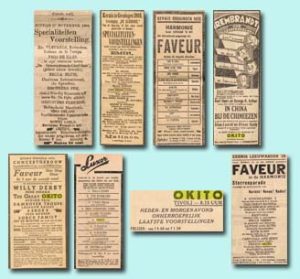
The content release of www.delpher.nl is the largest ever. It contains a large number of Dutch magazines.There are 17 hits when searching on “Okito” (numbers 36 through 46):
-36- Okito on stage in the Netherlands. De Amsterdamsche Dameskroniek (The Amsterdam Lady’s Chronicle) published a lengthy review about a famous variété (vaudeville) show. Facts that are already in chapter 17 are not mentioned in this summary. The article was entitled Het raadsel uit het Oosten (The riddle from the East). In the second part of the program the illusionist Kon-fu-tse appeared, dressed and typed as a Chinese. From thin, fluttering silk handkerchiefs he produced large bowls filled with water, from which real live geese fly up. Not just one, but three or four birds at a time. From a Japanese mat, which is hung on a rope and behind which nothing can be hidden, he conjures up a whole flock of geese; he makes a cute young lady jump out of an empty cardboard box, he mends cut ropes and cords in an incomprehensible way and pulls off one foolish thing after another. The craziest thing, however, is the trick with a golden ball, which rises and falls again at the beckoning of his hand, floats to the right and to the left. Kon-fu-tse was no one else than Okito, the most famous star in the sky of magicians and conjurers, of whom a layman recently wrote that he had died. […] Okito feels at home in this magic club. He was the first guest who ever appeared there and he remains loyal to his old friends. […] The article tells how Okito launched funny remarks in a most funny Dutch. (Of course, Theo Bamberg had no real real trouble when speaking Dutch.) ‘Oh, I must tell you a story, how I have… How do you say: kwown?… met Edison. Ik zijn in werkelijkheid eene Hollander, in Amerika naturalisé. O, ik moeten u vertellen eene story, hoe ik heef… How do you say: kwown?… kennen geleerd Edison. Ik was 1913 in Norfolk — Virginia. In alle hotels geene kamer. Hoe zegt men in Holland convention? Het was eene engineer-convention Daar ik tref op de straat eene oude vriend van mij. Hij zegt, ik kan wonen in zijne kamer in de hotel. Als wij dan zitten in de lobby, vraagt hij — hij was eene amateur magician — wat ik heb nieuws. Ik heb altijd eenige pocket-trics in mijne zak en ik ze hem vertoon. Daar, eene oogenblik later, staan twintig, dertig gentlemen om mij heen en ik werk eene uur voor enkel genoegen. En vóór mij staat eene zeer oude man, zeer erg vuil, de broek was te lang hem en eene witte pet zat hem scheef over zijne witte haar. En altijd houdt hij eene hand tegen het oor. Dan komt hij naar mij en vraagt mij, welke landsman ik ben. Ik heb gezegd, ik ben eene Hollander en ben in Amerika genaturaliseerd. Dan heeft hij gevraagd, of leeft mijne vader en waar. Ik heb gezegd, mijne vader leeft in Holland, maar ik heb niet geweten, waaróm hij vraagt. Dan heeft hij geantwoorden, als gij hem schrijven, dan schrijven gij, Thomas Edison says, he has a very clever son. En dan heeft hij mij gegeven eene brief, als ik komen naar Orange, dan kan ik alles zien. Maar ik ben nooit gekomen naar Orange. Maar die brief heb ik opbewaard.’ (Probably in The Hague – August 1, 1930). Chapter 17.
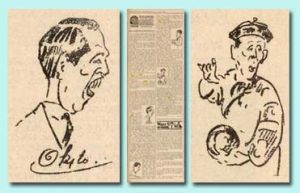
-37- Okito and Larette in the prestigeous Kursaal. In the same magazine De Amsterdamsche Dameskroniek, an advertisement was placed for a performance in the Kurzaal at Scheveningen of Okito and Larette, “an evening of higher magic art”. Their joint appearance was described in chapter 17, however, without the ad below (July 12, 1930). Later, Okito performed in the same venue, now with Prof. Rebus. (August 26, 1933). Chapter 17.
-38- Okito performing in vaudeville. The weekly Cinema and Theater reviewed the variété (vaudeville) show in Arena in Rotterdam, with Okito among others. “Okito is a smiling representative from the realm of illusion, a Chinese magician of a particularly refined nature. (Rotterdam January 1, 1931). Chapter 17.
-39- Reporting about Berlin. The magazine Het Leven reported about a trip to Berlin. “But suddenly, quite unexpectedly, a big Chinese man grabs my arm and pulls me along. He asks me not to take pictures during his ‘act’, because otherwise he would not be able to show his magic. Of course, I promise him that, but surely a snapshot can be taken in the dressing room?…. In the meantime, I stand looking at the Chinese man, called ‘Okito’, in amazement. What the devil, that man speaks Dutch just as well as we do! He sees and understands our amazement, and laughingly invites us to come with him to his dressing room, which request we of course comply with great pleasure. And here our Chinese man turns out to be a true Dutchman, an artist’s child, from the Bamberg family! The great illusionist Bamberg, who in his magic hours puts on a wig with a ponytail and covers his face with yellow make-up. Who knew that this astonishing magician was from Rotterdam? – But I don’t perform much in Holland, – our Chinese Bamberg told us, while we were taking pictures of him in his dressing room. I’ve just come from Berlin, and I’m going back there too. I’ve been all over the world. Yes, and I can tell you something nice; I was in Africa recently, and there I found your magazine as the only Dutch reading material!…. I really started to long for my country for a moment. Anyway, I’m here now, and in a few weeks I have to leave again. That’s just the way it is with us, variété people; wandering is our destiny. But remember, don’t take a picture of me now, when I’m working; I really can’t stand it! A bell rang. Next number. […] Excuse me, I think I have to go on. My goodness, how quickly it all goes!’ He led us through some dark corridors, and we nearly tumbled down a flight of stairs to get back on stage. Comment: Okito was in North-Africa the year before. This article proves that the photo (that was placed many more times) was taken by Dutchmen. (April 15, 1931). Chapter 17.
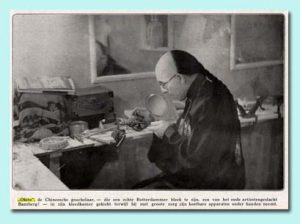
-40- Okito presented in the Netherlands. The same magazine Het Leven contained an article about Okito that was also placed in another periodical and reviewed in chapter 17. (August 8, 1931). Chapter 17.
-41-At the Rembrandt theater. There were several advertisements in the before-mentioned magazine De Amsterdamsche Dameskroniek for Okito’s performances in the Rembrandt theatre, at the interludes of the movie. In 1933 we see “Okito world-renowned illusionist”, in 1935 “Okito, the mysterious Chinese” and in 1936 “Okito, the mysterious Chinese illusionist.” (Haarlem July 15, 1933; January 1, 1935 and February 29, 1936). Chapter 17.
-42- Okito in London. The weekly Cinema en Theater visited the magicians of London. “In London there is a peculiar association called ‘The Club of Conjurers’. One could regard this club as a kind of professional association, of which a large number of the professional conjurers are members. This may sound a bit strange, because most conjurers naturally keep the secret of their tricks as carefully hidden as possible. The famous Chinese illusionist Okito, for example, the inventor of the ‘floating ball’, had the scenery, which he always took with him, constructed in such a way that one could not see onto the stage through any opening. Even the stagehands were unable to observe the tricks of the conjurer! (August 27, 1938). Chapter 17.
-43- Message in war time. The English-language Knickerbocker weekly: “The magician Loew worships the master magicians. In his estimation Houdini, of course, is the great master of all times but that the greatest living magician is a Hollander who performs under the Chinese-sounding name of Okito (his real surname is Bamberg). ‘Okito is known by magicians throughout the Netherlands and the world not only for his performances but as builder of magical equipment’, Loew elaborates, ‘his tricks cannot be copied because the construction is so intricate. All are works of art because of their minute and exact craftsmanship. Okito, who is now living in Mexico City, works long and lovingly on each piece of work and the result is so perfect that even he, himself, seldom attempts to duplicate the trick.’” (July 3, 1944). Chapter 17.
-44- Okito represented. The magazine De Uitgever (The Publisher), reported that Mary Louise Bamberg attended a meeting of the Dutch Publishers’ Association, on behalf of Okito (author of Magic Books), Chicago. (January 1, 1955). Mary was the daughter of Okito’s younger brother Simon Bamberg. Chapter 26.
-45- Okito’s niece interviewed (1). Multiple articles were published in the course of the life of Enny Mols-de Leeuwe, daughter of Rebecca Bamberg, sister of Okito. Such articles often shed more might on her famous family, especially on her grandfather David Tobias (“Papa”) Bamberg and het uncle Okito. The magazine Eva published two articles, the first one in 1957, entitled Mijn tijd van leven (My lifetime). In this interview, Enny (Engelina de Leeuwe) remarked that she was conjured onto the stage! In the literal sense of the word. When she was 4 years old she performed with her family somewhere in England. ‘And I also had “text”! I had a grandfather who was a magician. He was called “Papa Bamberg. Older people will probably remember that name. He was a “court magician”. He was very proud of that. He had performed magic at court twice, when Princess Wilhelmina was still a little princess. The royal coat of arms was on the door of his house, with hofmechanlcus (court magician) underneath. This coat of arms was also printed on his letterhead. Grandfather also recited. He was very versatile. Perhaps I have inherited some of his art of recitation through atavism. The son of this “Papa Bamberg” was Okito, a world-famous magician. My uncle, that is. He is still alive. Well over eighty and he lives somewhere in South America. (Comment: he lived in Chicago). His son, my nephew, who calls himself Fu-Manchu, is currently touring the world and is the “top of the bill”. He is probably an even better magician than his father. So, I descend from this magic family on my mother’s side. On my father’s side I can mention his brother Leo de Leeuwe as an artistic predecessor. For a lifetime he had a great career in Germany as an opera tenor and director, in various large cities. Last year, unfortunately, he died at a very old age. He was still singing when he was well over sixty. With the aforementioned uncle, Okito now, we used to tour England, Scotland and Ireland. My late father was his assistant. (Comment: that Louis de Leeuwe sometimes assisted Okito was known but not that he toured with him and his family in the United Kingdom). And my late mother traveled with us. I was, without realizing it, one of the highlights of this beautiful show, a show of world reputation. Okito traveled with staff and a wagonload of decors, props, attributes and costumes, Chinese costumes, authentic. (Comment: one more evidence of Okito’s logistics). Many magicians “conjure” live rabbits, canaries, goldfish and so on. He conjured me into existence. My first act. How did that go? I can’t tell you the secret. Our French friends would say: ce sont les ficelles du métier! But the act was as follows: Okito came on as a Chinese mandarin, black hair with a long braid, yellowish face with that typical position of the eyes, and now and then threw in a Chinese word. He wore several authentic mandarin costumes on top of each other. (And still he was a thin man.) Then he showed the audience a tambourine. Touched this with his “magic wand”. Before the astonished eyes of the spectators there came out in succession: ribbons… ribbons in all kinds of colours… almost without stopping; silk flags, flags, no little flags… This went on until a mountain of ribbons and flags piled up at his feet. Then he touched this mountain with his magic wand… and out of it came a miniature Chinese girl, completely dressed as such with a pigtail wig and all, who waved very freely to the audience and shouted “hello!” in her high, thin voice… That was me. I can still sometimes smell the make-up – in my memory – with which I had previously been transformed into a Chinese girl. The red lip make-up had such an attraction for me that one evening I ate a whole jar of it. To the great dismay of my dear mother. Nausea, vomiting, crying fits were the consequences of my misdeed. Never again, after that, did I eat lip make-up. Never again. […] Willem Royaards, the great theatre innovator at the time, had heard of my success in children’s roles. (Comment: this story with Royaards is also subject of chapter 17). Through the intervention of my grandfather, Papa Bamberg, for whom Royaards had great respect, I came into his company and under his strict direction. That did not last long. Father went to America on business. Mother and a little brother stayed in Holland for the time being. But I went with father to the New World. There too I played children’s and girls’ roles in various films, including at the “Fox-Film”. I could have gotten a very nice contract at the time. Unfortunately, this did not happen. Father became ill and had to return to Holland and he did not want to leave his daughter, in view of her age, alone in America. I found it terrible, but later I understood his kind, good intentions. Needless to say, my English gradually acquired an American accent. In Holland I was again engaged in the company of Willem Royaards.’ (September 21, 1957). Chapter 15.
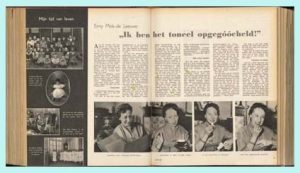
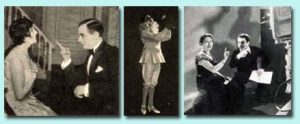

-46- Okito’s niece interviewed (2). In 1965, Eva placed a second interview with Enny Mols-de Leeuwe, in which she answered a couple of questions. Enny remembered her first appearance on stage (which adds more or less to text 45): “My grandfather was the famous magician, Papa Bamberg, and an uncle was just as famous as a magician. He performed as a ‘Chinese magician’ and called himself Okito. I went on tour with him as a four-year-old child through England, Scotland and Ireland. I was dressed as a Chinese girl and looked like a big doll. He conjured me off the stage and conjured me back again. Don’t ask me how he did it. I never understood it and I still don’t know.” She added: “My greatest hobby is the study of foreign languages. As a child of five I spoke English fluently, although I was not born in England and my parents were not English. But that was because of that tour through England, Scotland and Ireland, which I have already told you about.” (April 10, 1965). Chapter 15.

Most of the performances (see point 36 through 46) can be added to the timetable of Okito’s life (on the last pages of chapter 17). These will shed more light on his artistic movements).
-47- More articles about Bamberg in Dutch magazines. The release of Dutch magazines (see above) contains 731 hits when the search term is Bamberg. Many refer to the city of Bamberg. If a finding is about family members of the Bamberg dynasty, the content was already found before in other periodicals. For those who wish to wish to search those added magazines, select: https://www.delpher.nl/thema/nieuw/nieuwe-tijdschriften-03-12-2024.
-48- Street names for Bamberg. In 1960, two new street names were added to the city of Amsterdam. The Bamberghof (Bamberg Court), in memory of the Bamberg family, of which fame was enjoyed by David Tobias Bamberg, 1787-1858, magician, and Eduard Bamberg, 1816-1900, actor and director of the Salon des Variétés. At the same time the Boas en Judelshof (Boas and Judels Court) for Israel Pierre Boas, 1811-1886, and Nathan Judels, 1815-1903, directors of the de Salon des Variétés in the Amstelstraat. David Tobias Bamberg and his son Eduard Bamberg are subjects of chapters 4 and 7 respectively. Chapter 4 and 7.
Update January 2025:
-49- Illusion Show republished. In 1988, the great book Illusion Show was published, in linen cover, followed in 1991 by the hard cover edition. Many magicians, fans of magic and collectors sincerely liked this book, that reads like a novel and presents the fascinating life of David Tobias Bamberg, still known today as Fu-Manchu in Spanish and Portuguese speaking countries. This book has now been published in Spanish by Martin Pacheco, who runs the interesting Bazar de Magia in Buenos Aires. The book is described on the website Pasto Magic, also in Spanish.
‘Fu Manchu, a life for magic, the book that sees the light after a decade. Illusion Show is one of the most important magic books of all time, a cult work. It is the autobiography of, like me, one of the most important magicians of all time (everyone standing): David Bamberg, Fu Manchu. (Please sit down.) We’re talking about big words. This autobiographical work, which tells in Bamberg’s words the story of the entire dynasty of magicians as well as his incredible life and work, is out of print, the few copies on the market sell for good dollars, and to top it off it’s in English. Well, 50 years after his death Bazar de Magia, led by Martín Pacheco, announces the publication of Fu Manchu, A Life for Magic by David Bamberg. It’s not just the translation into Spanish of the great Illusion Show, it adds, as a result of Pacheco’s research, lost parts and investigations of the Bambergs’ lives, the story of one of their most famous acts: El Bazar de Magia and an article about its influence in the Hispanic world. More than 30 years ago, I read the English version of “Illusion Show” for the first time. Since then, I have been collecting memories, photographs and unpublished material related to Fu Manchu. I always dreamed of publishing a Spanish edition that would include all this valuable material, and now that dream has come true, says Martín Pacheco. This autobiographical work, which tells in Bamberg’s words the story of the entire dynasty of magicians as well as his incredible life and work, is out of print, the few copies on the market sell for good dollars, and to top it off it’s in English. Well, 50 years after his death Bazar de Magia, led by Martín Pacheco, announces the publication of Fu Manchu, A Life for Magic by David Bamberg. It’s not just the translation into Spanish of the great Illusion Show, it adds, as a result of Pacheco’s research, lost parts and investigations of the Bambergs’ lives, the story of one of their most famous acts: El Bazar de Magia and an article about its influence in the Hispanic world. “More than 30 years ago, I read the English version of ‘Illusion Show’ for the first time. Since then, I have been collecting memories, photographs and unpublished material related to Fu Manchu. I always dreamed of publishing a Spanish edition that would include all this valuable material, and now that dream has come true’ says Martín Pacheco.’
Testimonies tell us:
‘More than 30 years ago, one of the most wonderful magic books I have ever read came into my hands: “Illusion Show”, the life and work of the giant of Illusionism David Bamberg. Today, fifty years after the death of the great Master, Martín Pacheco publishes this long-awaited and long-awaited work in Spanish. He does so by taking the original to a superlative level, with extraordinary rigor, providing new data, unpublished information and visual and historical documentation that is inaccessible. This edition is beautiful, captivating, easy to read and very entertaining. In it you will discover an extraordinary life story. Not only that, but the book is a true Work of Art in itself, a work of excellence. Martín, thanks to your enormous dedication today we can say that Fu Manchu truly rests in peace.’ (Míchel).
‘Fu Manchu, a life in Magic, is not only the biography of the greatest magician in history, but a great palimpsest of all the magic of the 20th century. To read it is to enjoy a great novel and to feel, as José Ketzelman said, that Fu Manchu made sleight of hand an enchanting fable’. (Merpin).’
‘It is a great milestone for our magic literature that Martín Pacheco publishes the Spanish edition of Fu Manchu’s Illusion Show and that, in addition, he complements it with a large amount of material, both graphic and literary, that is not found in the original English editions. This book is one of the few that I have kept and the only one that I have read and reread more than five times in its entirety. All the experiences and adventures that Fu Manchu shares with us in this autobiography are entertaining and highly informative and allow us to follow step by step the artistic life of this great magician that was Fu Manchu. This is a book that I can recommend 100%.’ (Marko).
This is what the official text on the Bazar de Magia website says:
The book you are going to have in your hands is not a common autobiography, it is that of a successful, popular, globetrotting artist who filled theaters for months doing several performances a day and who lived a life like a movie. You will not have time to get bored, each page is an anecdote told with humor and intrigue and helps us spy on the difficulties and setbacks that the artists lived and also the enjoyment of their success. You will not find in it explanations of magic tricks, but you will find magic in its purest state and perhaps you will be able to understand a little how the minds of those peculiar beings who live for magic work.
-
-
-
- 440 pages printed in full color on high-quality paper.
- Hardcover and high-quality binding.
- Illustrated with more than 320 photographs of programs, posters, apparatus, costumes, accessories and unpublished material.
- Printed endpapers.
- Full-color dust jacket.
- Two registration tapes (bookmarks).
- Detailed name index.
- Published in 2024.
- The book is currently in pre-sale for USD 92 (later it will be USD 115) and will be available in Argentina starting December 15.
-
-
A deluxe-numbered edition of 100 copies is also available.
 Fu-Manchu’s son, Robert Douglas (Bob) Bamberg, told me that he received a pleasant surprise: Martin Pacheco’s sumptuous Spanish translation of Fu-Manchu’s Illusion Show. […] ‘The production of the book is stunningly good: it’s very large (30×23 cm), very heavy (thick paper), boxed, and I suspect very expensive. It’s profusely illustrated with a number of photos I’ve never seen. Many are enlarged to full-page format and printed with excellent clarity. It’s clearly a labor of love, and my father would have loved it. […] The appendices include excellent photos of costumes, illusions, etc. It seems he’s only printed 100 copies, but this is a de luxe production and perhaps he will publish something less elaborate in the future.‘ Chapter 24.
Fu-Manchu’s son, Robert Douglas (Bob) Bamberg, told me that he received a pleasant surprise: Martin Pacheco’s sumptuous Spanish translation of Fu-Manchu’s Illusion Show. […] ‘The production of the book is stunningly good: it’s very large (30×23 cm), very heavy (thick paper), boxed, and I suspect very expensive. It’s profusely illustrated with a number of photos I’ve never seen. Many are enlarged to full-page format and printed with excellent clarity. It’s clearly a labor of love, and my father would have loved it. […] The appendices include excellent photos of costumes, illusions, etc. It seems he’s only printed 100 copies, but this is a de luxe production and perhaps he will publish something less elaborate in the future.‘ Chapter 24.
Update February 2025:
-50- “Papa” Bamberg’s biography of the Bamberg family. On page 311 of chapter 11, the first three pages of the biography of the Bamberg family were shown. The complete set of pages is in possession of Dr. Bruce J. Averbook, Cleveland, Ohio, USA. The first pages are printed hereafter; the other five are too fragile to be scanned once more. The Dutch text was transcribed, although due to the readability, not all content could be included in the transcription. As mentioned in the PDF/book, it seems that David’s handwritten biography is the source of the extensive article by Oscar S. Teale in “The Sphinx” of August 1909.
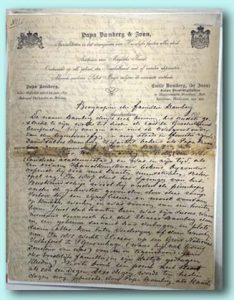
Much of the text is already known from other documents and testimonies and included in the PDF/book. Some other points of interest are:
-
- Apart from offering performances, David Tobias (“Papa”) Bamberg (and his son Emile) advertise as the Academy of Magic Art, teaching any type of conjuring, with or without apparatus.
- In many articles, different reasons were mentioned for the loss of a leg of Eliazer Bamberg, the founder of the dynasty. In this biography, the correct story was maintained by “Papa” Bamberg, so the family was aware of the real cause: the explosion of a gunpowder ship near his home in the city of Leiden.
- In 1812, Eliazer Bamberg, besides performing at a large national folk festival in The Hague, acted as the director of the event. He performed for the Royal Family, dressed in shorts, a wig with a tail and a sword. That sword was still in use by “Papa Bamberg” at the time when he wrote this biography.
- David Leendert Bamberg was an officer in the Order of Freemasonry for over fifty years and therefore became a protégé of Prince Frederik, brother of King Willem II.
- Tobias Bamberg was an educated and civilized artist, who spoke fluently French, German, English and of course Dutch. On request, he performed in those foreign languages.
- David Tobias (“Papa”) Bamberg started as a stage actor. The medals and diplomas that were rewarded to him for his performance as an actor and elocutionist garnish his cosy living room.
- “Papa” Bamberg lists a large number of persons from the Dutch and foreign nobility for whom he performed. The “Certificates of High Satisfaction” are kept by him.
- “Papa’s” son Emile Bamberg was educated as a pianist but changed this profession and became a magician. His manual dexterity is famous and his specialties are “Carte Tournée” wit 25 cards and his trick with 8 billiard balls is unsurpassable.
- Emile’s brother Eduard Bamberg performed already at the age of 13 in the largest specialty theaters of England, Scotland and Ireland. Today (1909) her performs in the USA as Edward Nelusco exclusively with manual tricks without apparatus.
The document was dated in Amsterdam on January 15, 1909. The table “DISAPPEARED?” on page 333 of the PDF/Book must be completed with the questions ‘where are the sword, the “Certificates of High Satisfaction” and the diplomas that were in “Papa’s” possession?’ Item 6 can de deleted because the current location of the biography was discovered as mentioned above, Chapters 3, 4, 6, 11, 17 and 24.
Update March 2025:
-51- Review of the Bamberg magic. In an article entitled El Pez (The Fish), dated June 2014, “a dynasty of inexplicably talented magicians. The Bambergs” is introduced. Juan Tamariz, who supplied much information about Fu-Manchu to the PFD/Book, is quoted “Black and red birds flutter in your hands and produce a thousand sparks of artifice between your fingers. The cardboard boxes dance an unpredictable dance today they transpose, they shift and transform into miracles.” The article provides general views on magic. Some remarks about the Bambergs are quoted here: “just a few steps from the River Plate, the last member of the Bamberg dynasty revolutionized world magic”; “He [Fu-Manchu] had a great sense of humor, he laughed at everything, he had a very fine sense of humor […] he has also been a magician who has known that emotion is more important than technique; that the emotion produced in the spectators – those of us who are watching the game at a given moment – is more fundamental than the effect of the game or anything else.” There are quite a few incorrect statements in this article, such as Fu-Manchu’s name David Tobias ‘Theodore’ Bamberg. Theodore was the name that his father Okito assumed. The earliest member of the family is called James Bamberg. The author must have meant Jasper Bamberg, who did not belong to this family at all. The wooden leg of Eliazer Bamberg was not an accident in the war, as the author mentions. Nowhere else Mephistopheles is mentioned, supposedly to be an invention of David Tobias “Papa” Bamberg. The author may have meant Galathea but Mephistopheles’ description does not match Galathea’s. That Papa Bamberg traveled around the world can only be true if the world was much smaller then. Just a few examples among others of stories that were repeated and altered again and again by many reporters.
Update April 2025:
-52- Barend David Bamberg wrote a book as well. Mr. Bruce Averbook obtained a booklet with some magic tricks that was published by Barend David Bamberg. Other members of the Bamberg family did the same. The title page shows the name B.D. Bamberg. That it was Barend who authored the booklet could be determined by his address, where he lived from 1899 through 1905. Chapter 10.
Update August 2025:
-53- Descendant of a Bamberg. In 2023, I was approached on behalf of an alleged descendant of David Tobias (“Papa”) Bamberg. Due to privacy reasons, no contemporary names are mentioned here, but they are known to your author. In chapter 18, we see that Simon Bamberg ran a boarding house from 1930-1934 in the Sarphatistraat in Amsterdam. A few years earlier, Simon and his wife had divorced. The father of the applicant was born in 1933 from a (short-lived) relationship between Simon Bamberg and a servant in Bamberg’s boarding house. Already late in 1933, the servant married someone else, and later, with the father of the applicant. The child was adopted into the new family. It is a plausible story. Simon Bamberg was not a happy person. In 1936, he was admitted to “Het Apeldoornsche Bos”, a Jewish institution for the mentally ill. At that time, all sorts of disorders were included there, including dementia. Chapter 18.

